Thanks. I hope you don't mind long boring intros.
Well, let's start with the map. I've drawn a map pixel-by-pixel, and I've seperated it by habitat by colouring each region of habitat a different colour. I will be involving continental drift in to the map, and the one I have posted is the current map which I'm working on. You'll notice that there is much less land coverage than our own Earth, but also the climate is warmer (so sea levels will be higher). If anyone knows much about how more sea coverage would affect climate, your advice would be much appreciated if you can give it.

Yo can see that I've numbered each one, and the colours generally start from the darkerst (tropical swamp forest) to the middle (tropical forest -> jungle -> scrubland / woodland -> grassland) to the bottom (semi-desert -> desert -> temperate vegetation -> tundra).
The species which I take in to account with the background flora and fauna are ones that existed in this particular time period which were not amphibians (which weren't descendants to modern-day amphibians) or land-dependant vertebrates. Everything else is taken into account, including the giant arthropod and fish species of that time. The only amphibian allowed is the one I'm evolving all the other species from - seymouria.

(<-google images) Quite honestly had no luck in getting a good picture of it... but I guess you get the idea for those who don't know seymouria.
So, I set my time period. 280 million years ago - when seymouria baylorensis is thought to have existed. That'll give me plenty of time. I had to organise my first species information before I could evolve it. I use a system based on survival, competition and adaptation in a particular area habitat and ability to emigrate by looking at each individual field in the specie's form. Here are all the fields:
Descendant of: The species which it evolved from.
Name: The name of this species.
Size: Size in centemetres and metres.
Area: The numbers representing the area on the map which this species belongs.
Habitat: What kind of environment and which part of the environment this species thrives in.
Breeding: Important behaviours, traditions, and physical developments involved in reproduction.
Feeding: How this species aquires enough nutrients to survive.
Senses: The senses involved with its interaction with the environment and detecting food or danger.
Strength: Physical features which exhibit need for physical power.
Resistance: Features involved in physical defence and resistance in water, ground or air.
Agility: How well the animal travels in its habitat, its stamina and metabolism.
Other behaviours: Anything else of interest about its behaviour.
---
And that's the form.
This is seymouria's form:
Descendant of: Primative tetrapod or lobe-fined fish, specifics unknown
Name: Seymouria baylorensis
Size: 60cm from nose to tail approximately.
Area: 24
Habitat: Permian swamps, in swamp water and banks of water.
Breeding: Unknown. May have laid eggs in the water and had a larval stage like amphibians, or it might have laid eggs on land which had shells, and bore developed offspring, like reptiles.
Feeding: Insects and small amphibians. In its native time it would also have fed on reptile eggs, but here it has been dropped into an environment absent of reptiles or competition. It most likely tilted its head backwards and chucked back its food deeper into its mouth as a form of eating.
Senses: It may have had a lateral line, and would have been able to sense approaching predators - or prey - in its natural aquious environment. Its probable that it had a sense of smell, but was also probably deaf, as it had evolved no organ to recieve and decipher airborne sound vibrations. It had eyes that poked upwards at the top of its head. This would have allowed it to see directly above, prhaps since it was so close to the ground and was exposed above in particular, or maybe to spot fish prey, or predators, in the water. Or it could have looked above the water line to wait for flying insects overhead.
Strength: It looked to be a fairly weak swimmer and seemed weak-limbed. Most of its strength was in its jaws.
Resistance: It had bony plates in its skull, formed in its skin, which would have offered some protection from predators.
Agility: It was not an agile animal, being cold blooded in an aquatic environment, it would have relied on the surrounding air of the warm tropical swamps to become active. Even so, it conserved rather than remaining active.
---
As you can see it belongs to area 24. That was me pretty much finished 280 mya.
So... for 278 mya....
I honestly had no idea what I wanted seymouria to evolve into. I payed attention to the surrounding areas... the descendants could adapt to these. Around was a couple af areas of swmp forest and a patch of rainforest. So, I'd make seymouria's descendants specialise at these areas...
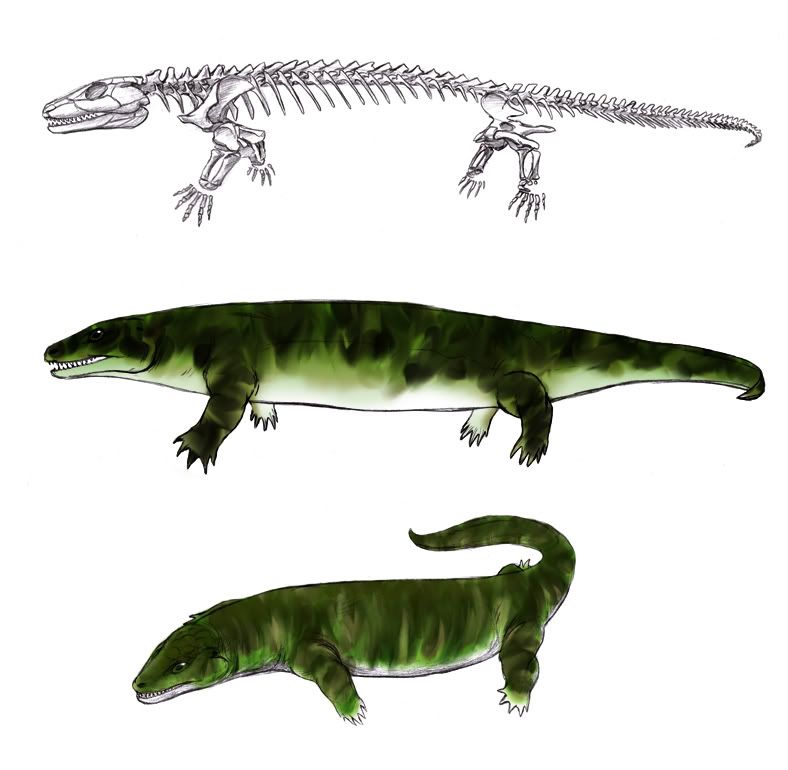 Descendant of:
Descendant of: 1. Seymouria baylorensis
Name: Seymaquious
Size: 65cm from nose to tail approximately.
Area: 21, 23, 24
Habitat: Permian swamps, in swamp water and banks of water.
Breeding: During most seasons the males and females mate, usually males, being bigger and stronger, will fight for the right to mate. Females lay their eggs in the water, and the eggs develop, usually protected by soft water vegetation. Offspring are larval, resembling tadpoles, and bear gills. They gain their adult form while they are still quite small.
Feeding: Insects and small amphibians, sometimes small fish. It tilts its head backwards and chucks back its food deeper into its mouth as a form of eating.
Senses: Bears a lateral line to detect danger in the water, and detect prey. The ear is simple, and its only purpose is to hear the approach of other amphibians or listen to the hum of flying insects it might want to eat. Its eyes poke upwards to see above the water to snatch insects and to look out for predators above on land and in water.
Strength: It moves its body and tail from side-to-side to swim, and can do so adequately. Its legs don't cope with land dwelling as well as its ancestor, but it surfaces from time to time.
Resistance: It has bony plates in its skull, formed in its skin, which offers some protection from predators. But it's still rather small and soft-bodied and is easily swallowed by some giant fish species or sharks.
Agility: Not agile, it is much more active in the water and is slightly faster than its ancestor. It only dashes in the water to escape an enemy, being cold-blooded it remains motionless a lot of the time to save energy, as its metabolism is slow. Quick reflexes however can be rather speedy.
Other behaviours:Males may use their tough skull for competing for a female.
---
and another....
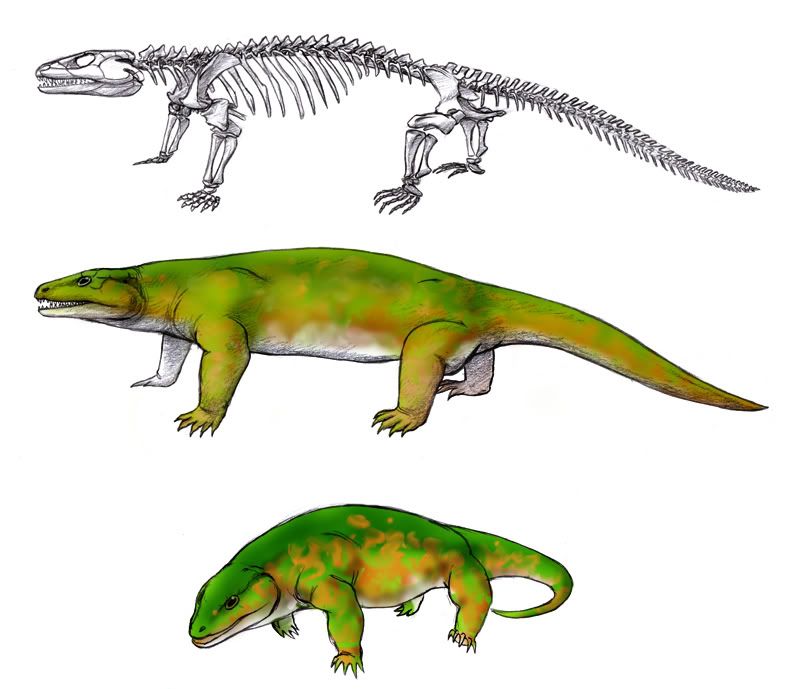 Descendant of:
Descendant of: 1. Seymouria baylorensis
Name: Seyterra
Size: 67 cm from nose to tail approximately.
Area: 24, 25
Habitat: Permian swamp forest and tropical rainforest, for some time in swamp or river water, and a lot of adult time spent on the forest floor.
Breeding: Females who have been mated take to the water to lay their eggs, which are small and jelly-like. Out from the eggs hatch poliwogs which have no legs, arms or a lung, and instead have a flat tail for swimming and gills to breathe in the water. The young grow their terrestrial adaptations over time, and have their adult atributes, losing their gills and tail membrane, by time they reach about two thirds of their adult size.
Feeding: Insects and small amphibians. It snaps them in its strong jaws and throws them back in its mouth by tilting its head backwards.
Senses: It shows to have a lateral line, useful in its aquatic larval stage and sensing danger when layng its eggs in the water. Their sense of smell is specialised for seeking amphibians, and it usually uses its movement responsive vision when seeking faster prey like flying insects and small arachnids. Its eyes are positioned furter to the sides of its head with a forward tilt so it could see better in a terrestrial environment.
Strength: Its a fairly weak swimmer and although its not fast on land, it's better than its ancestor at long distance travel and is still a stronger walker. Most of its strength is in its jaws for gripping slippery amphibians.
Resistance: It has bony plates in its skull, formed in its skin, which offere some protection from predators and male competition.
Agility: Not an agile animal, being cold blooded in an aquatic environment, it relies on the surrounding air of the warm tropical swamps to become active. It conserves rather than remaining active.
Other behaviours:
The strong skull is used by males for bashing each other over disputes for females to mate with.
---
And you know how the cycle continues. I'll post the rest of what I have so far...
[you]
276 mya[/you]
Descendants of seymaquious: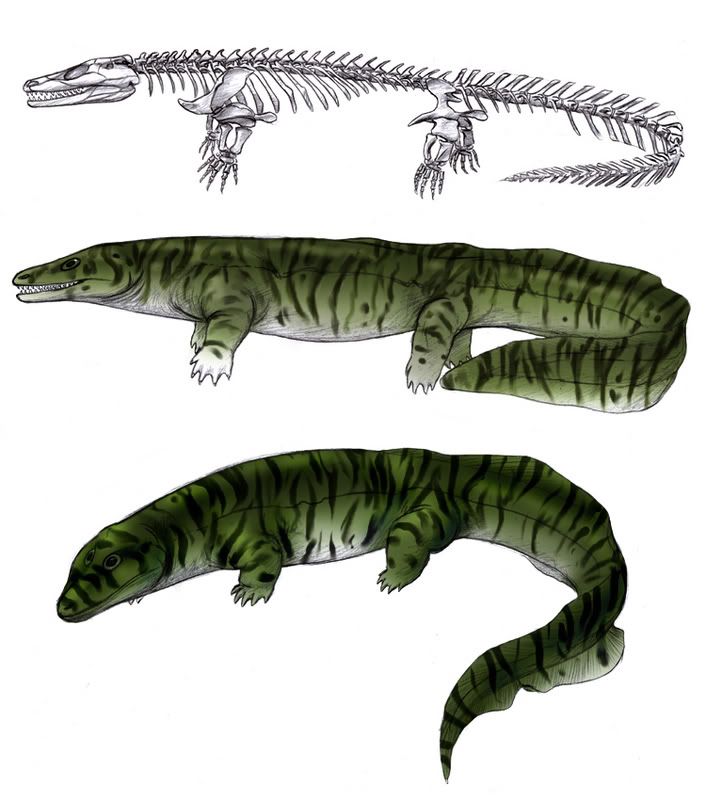
Descendant of: 1. Seymaquious
Name: Picphibian
Size: 70cm from nose to tail approximately.
Area: 24, 23, 21
Habitat: Permian swamps, in swamp water and banks of water.
Breeding: During most seasons the males and females mate, usually males, being bigger and stronger, will fight for the right to mate, often by using their needle teeth to pierce each other and cause pain. Females lay their eggs in the water, and the eggs develop, usually protected by soft water vegetation. Offspring are larval, resembling tadpoles, and bear gills. They gain their adult form while they are still quite small, but retain their gills for longer.
Feeding: Small fish, also arthropods and amphibians. It tilts its head backwards and chucks back its food deeper into its mouth as a form of eating.
Senses: Bears an accurate lateral line to detect danger in the water, and detect prey. The ear is simple, and its only purpose is to hear the approach of other amphibians or listen to the hum of flying insects it might want to eat. Its eyes poke upwards to see above the water to snatch insects and to look out for predators above on land and in water.
Strength: It moves its body and tail from side-to-side to swim, and can do so strongly and efficiently, gaining speed at minimal body temperature and energy expenditure. Its legs don't cope with land dwelling as well as its ancestor, but it surfaces from time to time, often to leave drying pools it might be trapped in.
Resistance: It has only a few bony plates in its skull, formed in its skin, which offers some protection from predators. But it's still rather small and soft-bodied and is easily swallowed by some giant fish species or sharks.
Agility: Not agile, it is much more active and swift in the water and is a good deal faster than its ancestor. It only dashes in the water to escape an enemy, being cold-blooded it remains motionless a lot of the time to save energy, as its metabolism is slow. Quick reflexes however can be rather speedy.
Other behaviours:
Males may use their teeth for competing for a female. Females deliberately lay their eggs in spongy vegetation.
---

Descendant of: 1. Seymaquious
Name: Cromaquious
Size: 73cm from nose to tail approximately.
Area: 24, 23, 21
Habitat: Permian deep water swamps, lakes, and banks of water, and also in wide rivers. Mostly found at the murky bottoms where it's hard to see anything.
Breeding: They mate at the start of the calmest seasons, males fighting between themselves before mating a female. Females seek shallow water with many water plants to protect the eggs, which are soft and jelly-like in texture. Offspring are larval, resembling tadpoles, and bear gills. They loose their gills and develop a lung, legs and proper jaws, later in development.
Feeding: As larvae they eat fungi, plankton, phytoplankton and algae. They later move on to gastropods, crustaceans, and arthropods, and when they get strong and large enough they will hunt small fish and amphibians.
Senses: Bears a sensitive lateral line to detect danger and prey in water. Its hearing is poor, and it better detects vibrations such as foot steps through its paws from the ground beneath it. Its eyes are small and are of little use except for detecting light, movement, shadows and shapes. This is due to its time spent in a murky environment where seeing is difficult. On the end of its nose are smell receptors so it can smell out prey from underwater even with its nostrils closed.
Strength: Its a strong swimmer, moving its streamlined body and memberane-supported tail from side-to-side as a form of propulsion. Its jaws aren't incredibly strong but have enough power to kill vertebrate prey up to about a third of its size, but it can only take on much smaller insects due to its killing point being its small, sharp pin-like teeth, perfect for slippery fleshy prey. Its legs are weak on the ground and can't carry the creature far, so it uses them instead for balance and direction change in water, much like flippers.
Resistance: Keratin scales provide protection from drying when it has to make emergency land journeys between water sources when its living space dries in drought. It also has bony plates in its skin to protect it from physical damage.
Agility: Its a strong swimmer in calm and fast water. Being cold blooded it can't move fast very often, but its body is designed for efficient movement with minimal effort and expenditure. It conserves energy when it doesn't need to use it, due to its slow metabolism. Avoids land whenever possible as it's far from agile or graceful there.
Other behaviours:
Their piercing teeth are used when they get agressive in most situations, but when competing for a female, males get so pumped up they may bash skulls together until one backs down.
---
Descendants of seyterra: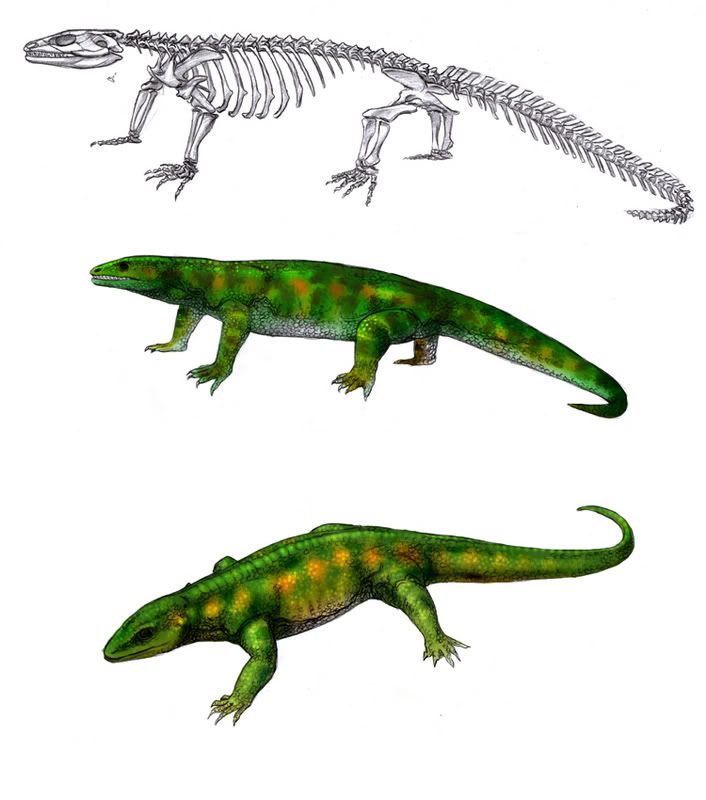
Descendant of: 2. Seyterra
Name: Nekizardish
Size: 59 cm from nose to tail approximately.
Area: 25
Habitat: Young poliwogs live in calm river and pond water and adults live on the tropical rainforest floor.
Breeding: They are tollerant of other members of its own species and often live very near one another. The advantage of this is that they don't have to search for a mate - there is usually always one near by. When females are receptive they give off pheramones which cause males to gather around her and mate with her several times. When too many males gather they will hiss and fight for their turn to mate, ad the strongest will get to first, and the weakest may eventually get a turn but it may be too late as the female may already be fertilized by this time.
Once the female has been mated enough times she feeds intensively for a few days then heads for water - she lowers her behind into the water, keeping in the shallows, and lays eggs in random places. The eggs may get knocked about as they're not secured, so they are laid in calm water and have a breathable hard rubbery coating to protect the embryo inside.
When the eggs hatch poliwogs appear - they must grow fast to avoid being eaten by aquatic creatures, and must do so without the parent's presence. They eat algae, insects and other larvae, and are born suprisingly well developed, with stubby 5-toed hind legs and flexible jaws. This is partially so they are strong enough to break their hard coated eggs, but partially so they are quickly ready to venture on to land.
Once their legs ar fully grown and their gills disappear they are still only around 10cm in length, but venture on land young and fend for themselves, eating molluscs, insects, arachnids and crustaceans, until they're fully grown.
Feeding: They usually eat arthropods of many kinds and also pick up molluscs and crustaceans, however they may scavenge washed up fish and primative amphibians the same time they go to rivers to drink. They also scavenge their own dead, and may even chance young nekizardish.
Senses: It has a lateral line in its poliwog stage, but this vanishes when its gills do. Their sense of smell is specialised for seeking other members of its own species, and may also lead it to food, and it usually uses its movement responsive vision when seeking faster prey like flying insects and small arachnids. Its eyes are positioned furter to the sides of its head with a forward tilt so it could see better in a terrestrial environment.
Strength: Adults are poor swimmers and will never swim if they don't have to, however their legs and tail are very strong and they can move them quickly, even acieving a trot when its scared or feels threatened. Some of its strength is in its jaws for gripping slippery amphibians. They have muscles between their ribs right up to their solar plexis which pull the ribs together, and relax to allow the ribs to part again, to allow air to circulate in the lung in greater quantities without having to gulp it through with their throat. This basic breathing action allows more oxygen to reach its brain and body cells.
Resistance: It has bony plates in its skull, formed in its skin, which offere some protection from predators and male competition.
Agility: It relies on the surrounding air of the warm tropical rainforest to become active, and is not fast when it doesn't need to be. However when threatened it will move quickly. It conserves rather than remaining active.
Other behaviours:
They produce a hissing sound to communicate, as they have very basic vocal cords. The mostly hiss to make other members of its species back off, and a louder hiss is created by a tougher individual.
---
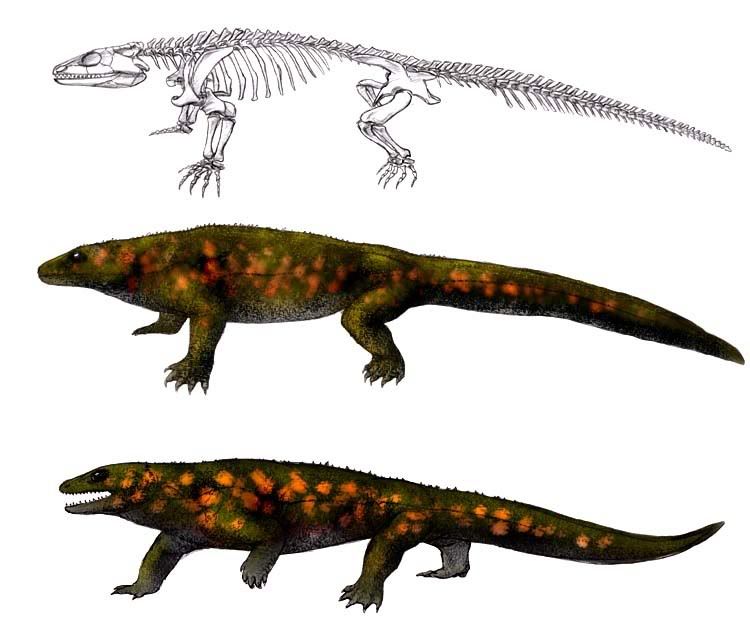
Descendant of: 2. Seyterra
Name: Terfin
Size: 63cm from nose to tail approximately.
Area: 21, 23, 24, 25, 20
Habitat: Swamp forest and tropical rainforest. Swims as well as it can walk. Larvae are found in shallow ponds and lakes.
Feeding: Fish, arthropods, small amphibians. Algae and plankton as larvae.
Breeding: Males and females gather to mate at the start of the calmer, drier season. This is so the ponds and lakes the poliwogs will grow in are calm and don't have strong currents. During other vtimes of year, although poliwogs are still produced, fewer survive when the weather is stormier.
Females look for murky water with plenty of vegetation to protect the soft eggs. The larvae hatch well developed with both a lung and a set of gills, but only the lung is retained in to adulthood. The lateral line is kept and as it ventures on to land it grows limbs.
Senses: Bears a highly sensitive lateral line to detect prey and danger in the water. Its ears can listen out for the approach of of the humming sound flying insects produce or the footsteps of terrestrial animals.
Strength: An adequately strong swimmer and land walker with power in the legs and tail to move it quickly during reflex reactions. The jaws are best suited for snatching smaller animals, but aren't good for tearing chunks of meat.
Resistance: All over its body are lumpy keratin scales. They offer as protection but also absorb heat as they're dark in colour. Bony plates run through its skin as added armour.
Agility: Can move at a good speed on both land and water. Being an animal with a slow metabolism and cold blood, it conserves most of the time, but has quick reflexes for when it needs them.
Other behaviours:
To earn their right to mate, males pin and bite their opponents.
---
[you]
274 mya[/you]
Descendants of picphibian: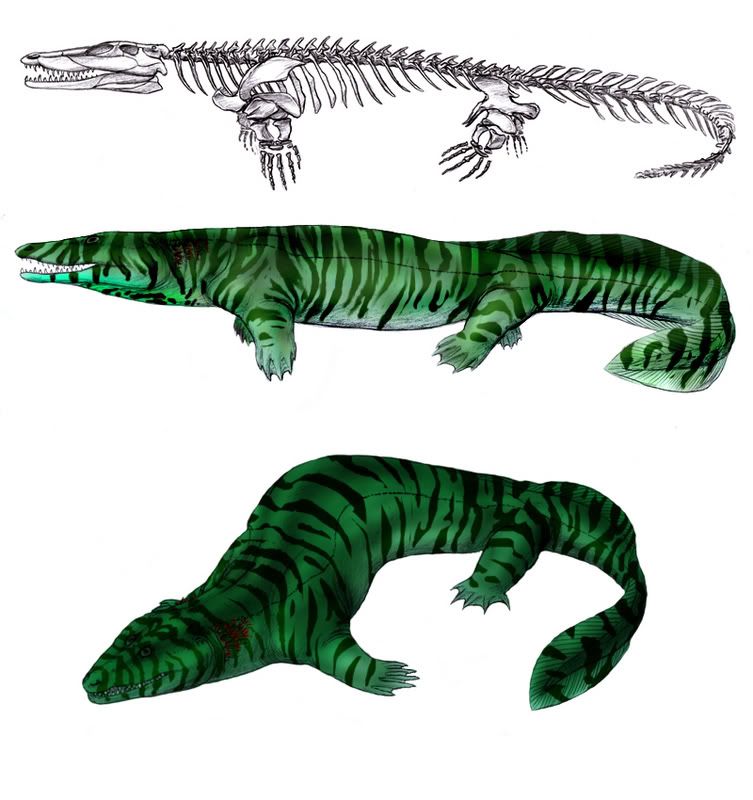
Descendant of: 1. Picphibian
Name: Gilpic
Size: 83cm from nose to tail approximately.
Area: 21
Habitat: Tropical swamp forests in deep swamp water, occasionally on mud travelling between water sources. Larvae dwell in shallower swamp water.
Breeding: Breeds during all times of year. Males will fight by first intimidating their foes by flicking water or mud with their stong tail. If this fails they will fight by biting and pinning their opponent. Females lay their eggs in shallow water with lots of vegetation, and the eggs develop, usually protected by soft water vegetation. Offspring are larval, resembling tadpoles, and bear gills. They don't develop legs or a lung until later, but they keep their gills and lateral line right until they die.
Feeding: Fish of many kinds. It can ambush scalphib (scalphib - a species I haven't scanned yet) from the water's edge. Their larvae feed on mostly smaller larvae, small fish and other tiny fleshy water animals.
Senses: Bears a highly sensitive lateral line to detect danger in the water, and detect prey. It spreads to its cheeks to broaden range. The hearing is poor and next to useless. Its eyes poke upwards to see above the water as in its murky environment there's no sense in trying to see through the cloudy water.
Strength: It swished its body and tail from side-to-side in waves to swim, and can do so strongly and efficiently, gaining speed at minimal body temperature and energy expenditure. Its legs are weak on land and can only drag it across slippery mud - it cannot walk. It has snapping jaws that clamp shut on its prey and mercilessly hold on until its prey stops struggling, or until its prey is shaken to death or drowned.
Resistance: It has only a few bony plates in its skull, formed in its skin, which offers some protection from predators. These ossified plates are also present sparsely under the skin. But it's still rather soft-bodied and is easily crushed by the jaws of some giant fish species or sharks.
Agility: Agile in the water and is a good deal faster than its ancestor. Its neck is quite agile for turning quickly to catch fish by suprise. It only dashes in the water to escape an enemy, being cold-blooded it remains motionless a lot of the time to save energy, as its metabolism is slow. Quick reflexes however can be rather speedy.
Other behaviours:
Males flick their heads to attract females, revealing their aqua and black pattern on the underside of its chin. Females lack the aqua in this colouring and only use it to threaten other females intruding on their egg-laying site. When males splash with their heads this is a warning to other males who might be a threat to its chances of reproducing.
---
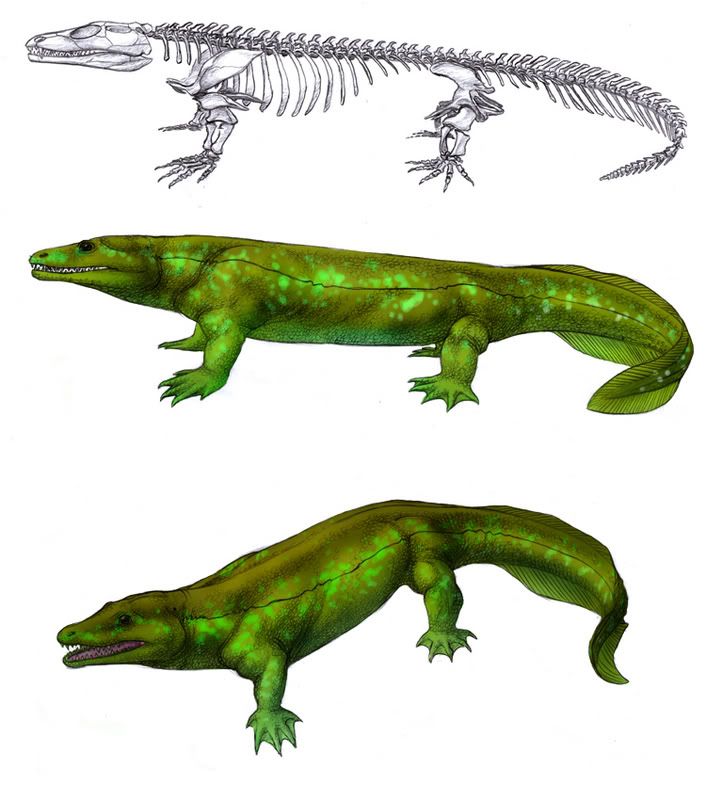
Descendant of: 1. Picphibian
Name: Piedpisces
Size: 76cm from nose to tail approximately.
Area: 23
Habitat: Permian swamps, in swamp water and on flat muddy land. Larvae common in pools, ponds and streams.
Breeding: At the start of the calmer seasons the males and females mate, males fighting off their fellow male competition by bashing and slashing with their jaws and claws. Females lay their eggs in the plentiful ponds, pools and streams, avoiding the often septic swamp water. She produces a lot of mucous to make laying them easier, and the eggs have an added membrane coating so the gripping hooks on their inner surface don't cling to the female. This membrane is lost almost right after the egg leaves the female. The hooks grip on to vegetation so the eggs aren't swept away in currents.
Larvae are born with a pair of gills, a lateral line and a tail membrane. The gills are lost with maturity and a lung and four limbs develop before adulthood.
Feeding: Arthropods, hard-shelled molluscs, crustaceans and many small fish. Larvae feed on arthropods and plankton.
Senses: Bears a sensitive lateral line to detect danger in the water, and detect prey. The ear is simple, and its only purpose is to hear the approach of other amphibians or listen to the hum of flying insects it might want to eat. Its eyes poke upwards slightly to see above the water to snatch insects but its also able to see forward and sideward at eye level.
Strength: The body ripples side to side in waves to swim. It's a good swimmer but it has compensated its better swimming ability for strength on land, with a set of strong legs to carry it quickly across land. The jaws are strong for crushing shells and gripping slippery prey.
Resistance: It has a few bony plates under its skin which offer some protection from predators. The ones in the skull are particularly broad and strong for battling rivals. Its flat scales can protect from drying and infestation, but don't offer much physical protection.
Agility: Can travel at a good pace on land, active and swift in the water. It only dashes in the water to escape an enemy, being cold-blooded it remains motionless a lot of the time to save energy, as its metabolism is slow. Quick reflexes however can be rather speedy.
Other behaviours:
Males may use their hard skulls for bashing one another in competition for females. Females deliberately lay their eggs in spongy vegetation away from swamp water as the eggs have become weak to septic water.
---
I still have more to finish on photoshop, I know I haven't got much just now. Hope this still gives you an idea of what I'm doing...